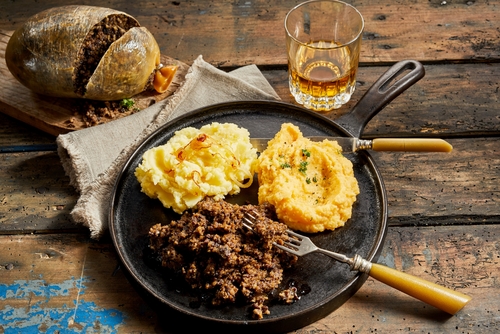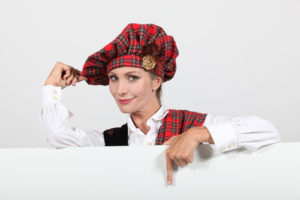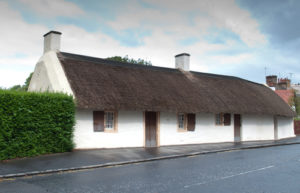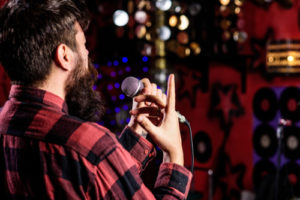
What is a Burns Supper?
Ever wondered what a Burns Supper is all about? And, just what happens? Do you like drinking, eating, poetry, singing, dancing, laughter, and all-around good banter? Then it’s likely you’ll enjoy a Burns Supper!
A Burns supper (or Burns Night) is a celebration of the life and lyrical works of Robert Burns, and in general, Scottish. Dubbed the ‘Scottish Bard’, few would counter the argument that ‘Rabbie’ Burns is Scotland’s most revered poet and lyricist. The suppers are held annually on, or near, the 25 January, the poet’s birthday. The celebratory night is not only held in Scotland, but in the rest of the UK, and potentially, at any location across the globe wherever Scots, or those with Scottish heritage, are resident or gathered.
For those with Scottish inheritance attending a supper, it’s considered good form to turn up in full Scottish regalia, kilt and all, in the tartan of your forefathers. However, it’s by no means compulsory but it is traditional to wear something tartan, even if it’s just a cap, socks, tie or scarf, etc. Conversely, even if you don’t have any connection with a Scottish name and you feel the urge, there are no rules barring you from wearing the full traditional Scottish attire, wearing whichever tartan you like.

A Brief History of the Burns’ Supper
The first Burns supper was held on 21 July 1801, when nine of Robbie Burns’ friends got together to mark the fifth anniversary of his death. They gathered at Burns’ Cottage at Alloway in Ayrshire, the house where Burns had grown up as a child. The night included a hearty meal, more than a few drinks, recitals of Burns’ work, and a speech in honour of the great man.
Those present unequivocally agreed that the night had been a resounding success and vowed to hold another the following year. However, they decided to switch the day of celebration to Burns’ birthday of 25th January, rather than the date of his death. Word spread quickly around Alloway of the ‘Burns’ celebration night. Others took inspiration and made plans to hold their own Burns’ supper. Within a few short years, the practice had spread throughout Scotland and beyond, until it became the phenomenon it is today.

Burns’ Cottage, Alloway – the birthplace of Robert Burns
A formal Burns Suppers will normally abide by something like the following itinerary:
Standard Order of Events
1. Piping in the guests
At large formal suppers, a suitably attired piper would generally meet the guests as they arrive at the venue. At smaller and less formal gatherings, traditional Scottish music would be played.
2. Welcoming speech
The host says a few words of welcome to his guests. It’s usually a short qualifying statement of the reason why they have gathered.
3. The Selkirk Grace
Once all guests are seated, grace is then recited. Traditionally, it’s the Selkirk Grace, which is delivered in the Scots language, the broad everyday dialect of 18th-century working-class Scots. Although often attributed to Bard, the Selkirk Grace is thought to have preceded Burns’ day. It was originally known as the “Galloway Grace” or the “Covenanters’ Grace”. It became known as the Selkirk Grace after Burns is said to have recited it at a dinner party given by the Earl of Selkirk.
4. The Meal

A typical Burns Supper of haggis, tatties and neeps
The starter to the meal is always a traditional Scottish soup, such as Scotch broth, potato soup, or cock-a-leekie. Likewise, the main course is traditionally haggis, tatties (mashed potatoes), and neeps (mashed swede). This was the same meal enjoyed by those present at the very first Burns’ Supper.
Everyone stands as the haggis is brought into the room. This is traditionally carried in by the cook on a large silver platter. If present, a piper will play one of Burns’ compositions, as the haggis is laid down at the host’s table. The host, or a designated guest, then recites Burns’ ”Address to a Haggis”. When the line ”His knife see rustic Labour dicht”, is spoken by the Addresser, they then theatrically draw and sharpen a large knife. And, at the line ”An’ cut you up wi’ ready slicht”, they then plunge it into the haggis, cutting it open from end to end.
At the end of the Address, the speaker proposes a toast to the haggis, to which everyone joins in, The meal is then served, which usually includes a traditional Scottish dessert. The dessert may then be followed by oatcakes and cheese, all washed down with the Scotch whisky.
5. Speeches and Toasts
At the end of the meal, various speeches and toasts are given in a set order.
Immortal Memory
Following the precedent set at the very first Burns Supper, the main speaker gives a tribute speech. Now known as the ‘Immortal Memory’, it praises the life and works of the Bard. It may then be followed by a recital of one of Burns’ poems or songs. A toast to the Immortal Memory of Robert Burns then follows.
Address to the Lassies

Originally, a short speech was given by a male guest thanking the ‘lassies’ who had prepared the meal. However, the speech known as the ‘Address to the Lassies’ is now normally more much wide-ranging. The amusing and anecdotal speech is usually written especially for the occasion, with a slightly mocking tone aimed towards those women present and to the foibles of the female gender, in general. When the speech is finished, the men then drink a toast to the lassies’ health.
Reply to the Laddies
The “Toast to the Laddies” is an amusing riposte by a female guest in response to the earlier speech by the male speaker. Like the previous toast, it is normally delivered in an amusing tone, picking up on the specific points raised by the previous speaker but also opines mildly mockingly on the whole of the male gender. When the speech ends, the ladies then drink a toast to the men.
Works by Burns
After the speeches, there is usually a performance of more of Burns’ work in the form of poems and/or songs that may be performed by professionals and/or simply by the guests themselves.
It may include works by other poets influenced by Burns, or some guests, particularly those of non-Scottish extraction, may be asked to perform something from their own background. For the energetic, the night may also include traditional Scottish dancing. This part of the night can go as long as the guests want it to continue.
6. Closing the Night
To end the night, the host will, or call on one of the guests to, give a vote of thanks to all those present. Then, everyone is asked to stand, join hands, and sing, arguably Burns’ most famous work, ‘Auld Lang Syne’, which brings the evening to an end.
Are you are thinking of hold your own Burns night? Then it’s entirely up to you how much, or little, of the standard order you follow.





